#Global Animal Model market
Explore tagged Tumblr posts
Text
Animal Model Market Size, Share, Top Companies, Growth and Research Report 2023-2028
IMARC Group has recently released a new research study titled “Animal Model Market: Global Industry Trends, Share, Size, Growth, Opportunity and Forecast 2023-2028”, offers a detailed analysis of the market drivers, segmentation, growth opportunities, trends and competitive landscape to understand the current and future market scenarios. How big is the animal model market? The global animal…

View On WordPress
#Animal Model Market#Animal Model Market 2023#Animal Model Market Analysis#Animal Model Market Report#Animal Model Market Share#Animal Model Market Size#Global Animal Model Market
0 notes
Text
Follow-up to my Fanroad Magazine archival scan post - let's look at some cute 90's anime art! Just random ones that caught my eye:

"Hey, what happened to me!?" As mentioned, this came out before End of Eva did - as such, Asuka & crew really didn't get much of an ending in the TV show. 100% how she would react to watching episode 26, props to our artist (春原てるも/Kasuhara Terumo)

There are just so many "Rei running with toast" pieces, it was clearly a combination of a meme amoung the fans and the theme for the magazine. Love how this one brought marmalade too - never compromise on taste, no matter how late you are.
(The artist's name is "actually, I'm a Shinji fan" btw lol)

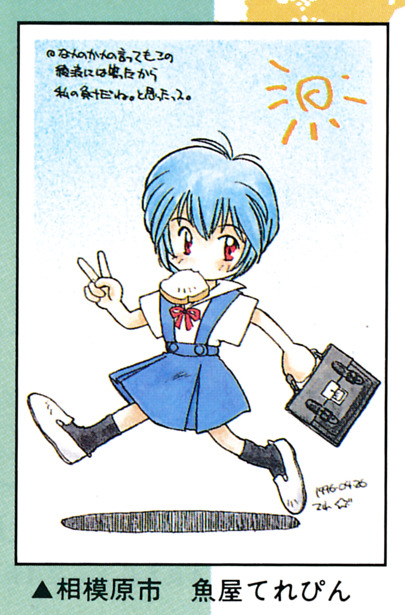
I love finds like these - these toast-lugging Rei's are by people who are professional mangaka today! The first is by いちば仔牛/Ichiba Kousei, or "Marketplace Cow" - it ain't their birth name I am sure - and they are a founding member of the doujin circle UGO - which is still going strong! And our second is by (I am 80% sure on this one) うおなてれぴん/Uona Terepin, a quite-accomplished artist who adorably published their first professional work in 1997, a year after this. Their twitter feed is 50% big titty girls and 50% model tanks, absolutely based.

Hot👏Shinji👏Fucks👏, this piece is amazing. What else do I have to say? (緋月れん/Hizuki Ren - maybe, translating Japanese names with no context is hard guys -_-)

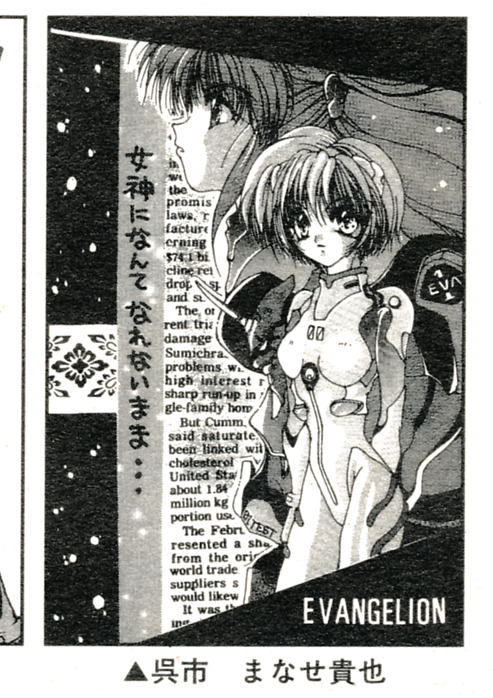
This is one of my favourite trends - so Evangelion has a lot of technobabble? And it is very frequently in English. So fans really liked recreating that aesthetic in their art. But in 1996 they didn't have access to like screengrabs from the show or scanned splatbooks on hand? Which meant they just used ~whatever English text they could find - generally newspapers at their university or library. Which means we get Toast Rei splashed on reports of stock indices in the global financial markets, and this beautiful moe-Rei/Asuka looking solemnly out over, uh, some report about housing prices and cholesterol levels? Technobabble indeed! (嶋屋みえ/Shimaya Mei, まなせ貴也/Manase Takaya)
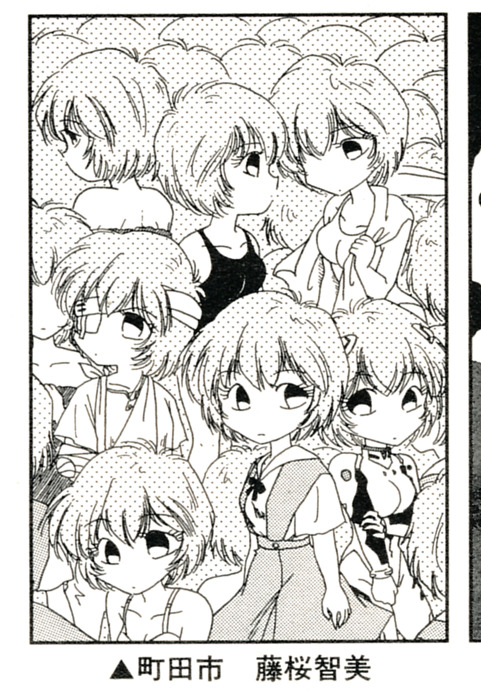
Rei clone army! Adorable. (藤桜智美/Fujisakura Tomomi)
Okay, moving away from Eva, there is in fact a bunch of other properties in here with fanart, but these types stood out to me:


That seinen "Kids on the Street" energy that was peaking in the 90's; fully ~aesthetic. (Keiko Kuyuki)
And to end on a weird note:
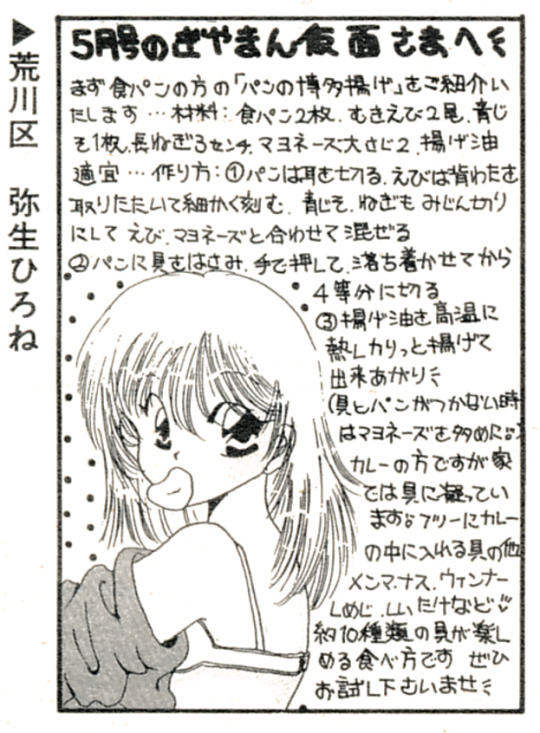
One section of the magazine is just a free-for-all of thoughts, and one Yayoi Hirone decided to give us a girl caught in the middle of undressing...alongside a recipe for cooking shrimp. Which, if I am being honest, is a huge improvement over the bullshit they throw on recipes online these days. This is the future we could have had -_-
Anyway, I hope that was fun - if anyone is struck or amused by some of the art in the magazine, I would be happy to see what stood out to you!
94 notes
·
View notes
Text
Very interesting new and different business models and business ideas for rural markets in global North.
Millennial Farmers: The New Fashion Pioneers
One of the most exciting aspects of this movement is the connection between millennial farmers and the fashion industry. Here are some real-life examples.
• Regenerative agriculture for textiles in which millennial farmers are increasingly adopting practices focused on improving soil health, conserving water and sequestering carbon. Some farms are now growing cotton, flax and other fibers using regenerative techniques. These materials are used in fashion and represent a significant shift away from traditional, resource-intensive farming.
• The use of organic and eco-friendly dyes in textile production is on the rise. Many millennial farmers are experimenting with plant-based dyes — such as indigo — and incorporating them into fashion. These natural dyes not only reduce the environmental impact but also create unique, earthy colors.
• Farms that raise animals for wool, leather and other textiles are taking a more ethical approach. By ensuring the welfare of the animals, these farmers are producing high-quality, sustainable materials for fashion brands that prioritize animal welfare.
• Millennial farmers are embracing the direct-to-consumer model, much like they do with farm produce. They sell fibers and materials directly to fashion brands, cutting out intermediaries and ensuring transparency in the supply chain. This connection appeals to fashion brands that want to know where their materials come from.
• Millennial farmers are also choosing to wear and support sustainable fashion brands that align with their values. It’s a way of living the principles of slow living not just in farming but in every aspect of their lives.
#solarpunk#solarpunk business#solarpunk business models#solar punk#farmers#slow life#sustainable lifestyles#rural
16 notes
·
View notes
Text
The phone or computer you’re reading this on may not be long for this world. Maybe you’ll drop it in water, or your dog will make a chew toy of it, or it’ll reach obsolescence. If you can’t repair it and have to discard it, the device will become e-waste, joining an alarmingly large mountain of defunct TVs, refrigerators, washing machines, cameras, routers, electric toothbrushes, headphones. This is “electrical and electronic equipment,” aka EEE—anything with a plug or battery. It’s increasingly out of control.
As economies develop and the consumerist lifestyle spreads around the world, e-waste has turned into a full-blown environmental crisis. People living in high-income countries own, on average, 109 EEE devices per capita, while those in low-income nations have just four. A new UN report finds that in 2022, humanity churned out 137 billion pounds of e-waste—more than 17 pounds for every person on Earth—and recycled less than a quarter of it.
That also represents about $62 billion worth of recoverable materials, like iron, copper, and gold, hitting e-waste landfills each year. At this pace, e-waste will grow by 33 percent by 2030, while the recycling rate could decline to 20 percent. (You can see this growth in the graph below: purple is EEE on the market, black is e-waste, and green is what gets recycled.)
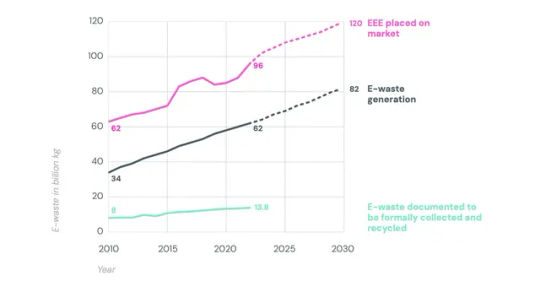
“What was really alarming to me is that the speed at which this is growing is much quicker than the speed that e-waste is properly collected and recycled,” says Kees Baldé, a senior scientific specialist at the United Nations Institute for Training and Research and lead author of the report. “We just consume way too much, and we dispose of things way too quickly. We buy things we may not even need, because it's just very cheap. And also these products are not designed to be repaired.”
Humanity has to quickly bump up those recycling rates, the report stresses. In the first pie chart below, you can see the significant amount of metals we could be saving, mostly iron (chemical symbol Fe, in light gray), along with aluminum (Al, in dark gray), copper (Cu), and nickel (Ni). Other EEE metals include zinc, tin, and antimony. Overall, the report found that in 2022, generated e-waste contained 68 billion pounds of metal.
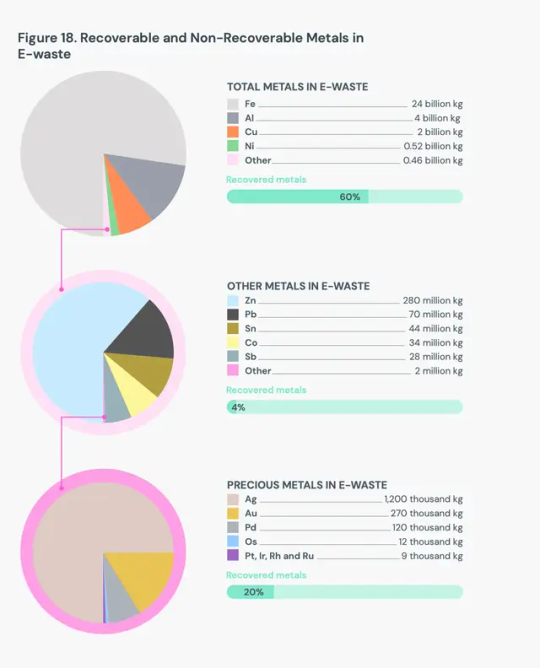
E-waste is a complex thing to break down: A washing machine is made of totally different components than a TV. And even for product categories, not only do different brands use different manufacturing processes, but even different models within those brands vary significantly. A new washing machine has way more sensors and other electronics than one built 30 years ago.
Complicating matters even further, e-waste can contain hazardous materials, like cobalt, flame retardants, and lead. The report found that each year, improperly processed e-waste releases more than 125,000 pounds of mercury alone, imperiling the health of humans and other animals. “Electronic waste is an extremely complex waste stream,” says Vanessa Gray, head of the Environment and Emergency Telecommunications Division at the UN’s International Telecommunication Union and an author of the report. “You have a lot of value in electronic waste, but you also have a lot of toxic materials that are dangerous to the environment.”
That makes recycling e-waste a dangerous occupation. In low- and middle-income countries, informal e-waste recyclers might go door-to-door collecting the stuff. To extract valuable metals, they melt down components without proper safety equipment, poisoning themselves and the environment. The new report notes that in total, 7.3 billion pounds of e-waste is shipped uncontrolled globally, meaning its ultimate management is unknown and likely not done in an environmentally friendly way. Of that, high-income countries shipped 1.8 billion pounds to low- and middle-income countries in 2022, swamping them with dangerous materials.
High-income countries have some of this informal recycling, but they also have formal facilities where e-waste is sorted and safely broken down. Europe, for example, has fairly high formal e-waste recycling rates, at about 43 percent. But globally, recycling is happening nowhere near enough to keep up with the year-over-year growth of the waste. Instead of properly mining EEE for metals, humanity keeps mining more ore out of the ground.
Still, the report found that even the small amount of e-waste that currently gets recycled avoided the mining of 2 trillion pounds of ore for virgin metal in 2022. (It takes a lot of ore to produce a little bit of metal.) The more metals we can recycle from e-waste, the less mining we’ll need to support the proliferation of gadgets. That would in turn avoid the greenhouse gases from such mining operations, plus losses of biodiversity.
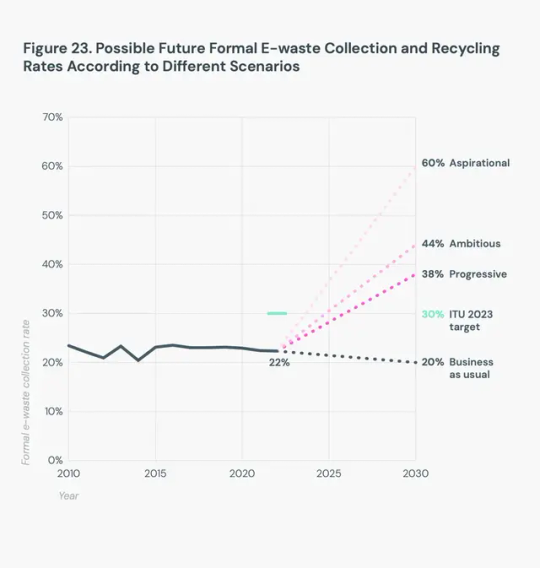
The complexity of e-waste, though, makes it expensive to process. As the chart above shows, even an ambitious scenario of a formal e-waste collection rate in 2030 is 44 percent. “There is no business case for companies to just collect e-waste and to make a profit out of this in a sustainable manner,” says Baldé. “They can only survive if there is legislation in place which is also compensating them.”
The report notes that 81 countries have e-waste policies on the books, and of those, 67 have provisions regarding extended producer responsibility, or EPR. This involves fees paid by manufacturers of EEE that would go toward e-waste management.
Of course, people could also stop throwing so many devices away in the first place, something right-to-repair advocates have spent years fighting for. Batteries, for instance, lose capacity after a certain number of charge cycles. If a phone can’t hold a charge all day anymore, customers should be able to swap in a new battery. “Manufacturers shouldn't be able to put artificial limitations on that ability,” says Elizabeth Chamberlain, director of sustainability at iFixit, which provides repair guides and tools. That includes limiting access to parts and documentation. “Repair is a harm-reduction strategy. It's not the be-all-end-all solution, but it's one of many things we need to do as a global society to slow down the rate at which we're demanding things of the planet.”
At the core of the e-waste crisis is the demand: A growing human population needs phones to communicate and fridges to keep food safe and heat pumps to stay comfortable indoors. So first and foremost we need high-quality products that don’t immediately break down, but also the right to repair when they do. And what absolutely can’t be fixed needs to move through a safe, robust e-waste recycling system. “We are consuming so much,” says Baldé, “we cannot really recycle our way out of the problem.”
26 notes
·
View notes
Photo










Hino Contessa 1300 Coupé
The name Hino was taken from the homonymous town in the Tokyo prefecture where the company's headquarters were (and still are). His first steps were to create powerful military vehicles for the Imperial Japanese Army during World War II. Once the greatest war of all time was over, it dedicated itself to the manufacture of diesel engines, trucks and buses. The post-war Japanese automobile industry underwent a major transformation thanks to the numerous agreements that many manufacturers made with car brands in Europe and the United States. Hino was no different. The operations were going from strength to strength, they had already earned an important place in the industry and even theirs was the first trolleybus in the history of Japan. The brand wanted to expand its business by launching into the world of passenger cars. Already under the name of Hino Motors, it signed a collaboration agreement with Renault in February 1953 and two months later they began to manufacture the Renault 4CV (also called Renault 4/4) under license. In Japan it was marketed as the Hino PA and some 35,000 units were sold in the 10 years it was in production. The French brand ceased production of the Renault 4CV in 1961, so Hino set out to take another step in the automotive world: manufacture its own car. They contacted the prolific Italian designer Giovanni Michelotti, who had worked with brands as relevant as Ferrari, Lancia, Maserati, Alpine or Triumph, to draw the silhouette of the new Japanese car.
The Hino Contessa 900 used the base of the Renault 4CV but at first glance no one could recognize that link due to the charming sedan body designed by the Turin designer. Renault's 35 hp 0.9-litre engine was positioned at the rear and was sufficient to animate the rear axle with the 750 kg that the car weighed. Shortly after, the Hino Contessa 900 Sprint was launched, a coupe version that reduced the weight by 100 kg and had an engine powered by Nardi up to 45 CV. With an attractive design, greater habitability -it offered space for five passengers, one seat more than the 4CV- and the proven reliability of its engine, it was not surprising that the Contessa achieved good sales results. 47,299 units were marketed between 1961 and 1964, a small part of them manufactured beyond the Japanese borders. The great reception in the market of its first car encouraged Hino to develop the second generation. Once again, Michelotti was in charge of its design, who had an overwhelming personality. The front with double optics and no grille was clearly reminiscent of the Chevrolet Corvair while the general lines were similar to other models designed by Michelotti such as the Triumph 2000. The Italian designer had been inspired by the English and American cars for this Japanese model with a French engine. Long live globalization! The Hino Contessa 1300 was bigger and heavier than its predecessor, but also more powerful by using a 1.3-liter 55 hp engine from the Renault 8. It began its commercial journey in 1964 and a few months later the sports version with bodywork arrived. two-door, the Contessa 1300 Coupé with 65 CV. The second generation of the Contessa was exported to several countries around the world, being manufactured in Japan, Israel and New Zealand.
81 notes
·
View notes
Text


People
Hunger Has Natural Causes, Right?
Despite the fact that the world produces 1.5 times as much food as is needed to feed the human population, starvation and famine are endemic to modern capitalism. 900 million people die from starvation each year, but there is no global shortage of land to grow food. The UN estimates that there is enough land to feed a world population of 14 billion people. But what is it being used for? As in the ‘developed’ North, large landowners control the vast majority of land. In 83 countries, 3% of farmers control 79% of farmland, much of it left unused in order to maintain profits. Big Food made over $7bn profit from the South in 1990, and probably far more through transfer payments. It uses its economic power to force down the prices of rice, coffee, sugar, cocoa and cotton. Average prices in 1989 were 20% down on those of 1980. This led to an increase in foreign debt for Southern countries, with consequent increased economic hardship for the poor majority (higher taxes, inflation, etc.). Brazil has an area of farmland the size of India left uncultivated while 20 million rural poor are landless; the richest 1% owns 15 times as much land as the poorest 56% of Brazilian farmers. In Guatemala, 2% of landowners own 66% of the land. In the Philippines agribusiness producing sugar, cotton and pineapples for export has pushed 12 million peasants into the lowland forests.
Drought in Africa is part of a millennia-long cycle that human societies adapted to. It is cash crop exploitation, the market economy and taxation that produce starvation, not drought. During the 1970s, when famines first began to be reported regularly, ships that brought relief supplies to the port of Dakar left carrying peanuts, cotton, vegetables, and meat. In Bangladesh, often cited as the model for the Malthusian argument, 90% of the land is worked by sharecroppers and labourers. Many starved after the 1974 floods, while hoarders held on to four million tons of rice. In the mid-80’s severe famines occurred in the Sahel countries of Burkina Faso, Mali, Niger, Senegal and Chad yet during the same period record harvests of cotton were exported to the industrial centres of the world.
Cash crops go to feed the global supermarket, yielding higher profits for international capital and accelerating global industrialisation. Mexican soil and labour supplies almost 70% of the US market for much winter and early spring vegetables. The result is that agriculture for local consumption is squeezed out and the prices of staple foods rise. Up to 50% of total meat production in Central America is exported, mainly to North America. The “Green Revolution” of the 1970s and 1980s, that the ruling class said would feed the hungry, has in fact only supplied the global supermarket. The same will certainly be true of the ‘wonder crops’ of the GM revolution. The corporate claims that GM and industrial food production in general will ‘feed the world’ are straightforward lies. The maize/soya/ animal product system they are pushing so heavily is not a rational way to produce food — an acre of cereal is estimated to produce 5 times as much protein as one devoted to meat production, an acre of legumes (beans, peas, lentils) 10 times as much and an acre of leafy vegetables 15 times as much.
#hunger#humans#world hunger#classism#ecology#climate crisis#anarchism#resistance#community building#practical anarchy#practical anarchism#anarchist society#practical#revolution#daily posts#communism#anti capitalist#anti capitalism#late stage capitalism#organization#grassroots#grass roots#anarchists#libraries#leftism#social issues#economy#economics#climate change#climate
5 notes
·
View notes
Text
Eden of the East

Addressing Issues in Japan and Globally
Eden of the East" begins with the main character, Saki, expressing hopelessness about Japan’s future, feeling that meaningful change is impossible. This sentiment supports how resistant the Japanese work culture is to change and reform.
Globally, the series critiques neoliberal policies that emphasize individual competition at the expense of social welfare. The NEETs (Not in Employment, Education, or Training), represent young people let down by a system that offers little in terms of job security or personal fulfillment. This resonates on a global scale as many societies currently grapple with high youth unemployment, economic inequality, and the alienation of younger generations.

Relating to the Average American Life
While the story is about the flawed Japanese system, the themes are universally relatable. The challenges faced by NEETs parallel those of many young Americans who struggle with student debt, uncertain employment, and the rising cost of living. While young college graduates are able to find jobs compared to the Japanese, they’re unable to buy or rent a home as easily as the Baby Boomers and Generation X. The anime’s criticism of exploitative corporate practices and the pursuit of economic success reflects on concerns shared by many in the U.S., where the gig economy and rising inequality have reshaped the landscape of work.

Connections with "Work Culture" by Ross Mouer
Ross Mouer's chapter on Japanese work culture provides a valuable backdrop for understanding the issues related to the main characters in Eden of the East. Mouer discusses the evolution of work in Japan, from the postwar economic boom and the lifetime employment system to the current challenges posed by economic stagnation and labor market deregulation. The anime vividly portrays these shifts through the lens of young characters who reject traditional employment models in favor of more alternatives.
Mouer's insights into the historical context of Japan's work culture helped me better understand the story line. The long working hours that once defined success are shown to be increasingly out of touch with the needs and aspirations of modern youth.
9 notes
·
View notes
Text
I guess since theres an official post made now, its a good opportunity to say my thoughts on the reboot animation 😗
I've seen clips here and there of both animation releases for Winx Season 9, though at this point its a bit up in the air for which one is the "finalised" animation
The global release version feels a bit less detailed and has less dramatic lighting, i think the hair models also feel a bit more flat and have less stronger shapes (see: bloom's fringe)
The comicon release clips feel more polished imo, especially with the stronger lighting, more detailed backgrounds in certain shots and stronger facial expressions. I personally prefer this version overall, but with 1 exception: I much prefer mitzi's face and glasses in the global release, as she seems to have sharper features there. Also, I actually quite like Mitzi's design 🥺
Overall, considering I was expecting much less, the animation exceeded my expectations! I strongly disliked the 3D animation in later movies and S5, and was v scared that they would use the same models. But I'm glad they are taking the time to cook and make this seem more polished, albeit I'm a bit scared about the overall reception considering this seems like a high budget release + many ppl seem shocked that its in 3D at all.
A 2025 release date though...I'm gagged 😭 It keeps getting pushed back 😔 Winx pls release more teasers and marketing for this eventually I need smth to stay afloat lol
13 notes
·
View notes
Text
Scholars Kim Hanjae and Kim Jongik on sharing manhwa globally

Manhwa has seen a huge boom with English-language audiences over the past several years. A few manhwa titles were localized during the manga boom of the 2000s, largely through Tokyopop, but online subscription service WEBTOON changed the game when it launched its global version in July 2014—beating Shonen Jump to the launch of their app by two months. Webtoons held a unique allure compared to online manga available at the time: they’re predominantly fully colored and formatted to be read on mobile, and services like Lezhin Comics featured an addictive pay-by-the-chapter model.
Though South Korea’s relationship with Japan remains fraught to this day, bans on Japanese media in Korea were lifted in the 1990s; and since the Webtoon boom, manhwa have become increasingly popular subjects for adaptation into anime, from The Tower of God and Why Raeliana Ended Up at the Duke’s Mansion to the upcoming Solo Leveling. And yet, there continues to be a relative dearth of manhwa-related guests invited to American conventions.
Otakon 2023 decided to address this dearth by inviting several manhwa artists and experts, two of whom sat down with us for an interview. Kim Hanjae is a Manhwa, Animation, and Contents professor at Gangdong University whose convention biography described her as “one of Korea’s top Otaku professors. She debuted as a manhwaga at the age of 21 and majored in Cartooning at the School of Visual Arts in New York. She has a master’s degree in animation and a PhD in Emotional Engineering.” Speaking through a translator, she elaborated on her study of emotional engineering as approaching the technical construction of art, marketing, and AI through the frame of human experience.
Read it at Anime Feminist!
18 notes
·
View notes
Note
This thought isn't entirely formed, and I can't make sense of it, but it's really weird how the writers use suffering as a cosmetic signifier for villain status instead of a symptom that reveals the true evil sickness... that is capitalism and hoarded power.
Adam has a branded eye revealed before his death, it shows the disregard for faunus life and how a global conglomerate built capital and shaped the landscapes of society through faunus exploitation and abuse, but adam's suffering as a faunus is just a reason for his madness. Ozma is cursed by god to live as a parasite, watched his children get murdered, and was hunted for centuries by his abuser in a never ending cycle of suffering, but that is all just background stuff for why he lies and trusts no one. Even Cinder was raised in an orphanage where living conditions are abysmal thus showing the lack of social protection and welfare for children, she got human trafficked and wore an electrical collar thus showing how there is canonically a market for slavery, and the huntsman that wanted to help her had no legal channels of freeing her, but that is all just set dressing for why cinder craves power.
I am so confused, because these characters are supposedly hate sinks, especially Adam in particular. Miles has gone on record going on about how he hates adam and he is disgusted while writing adam. And like, my dear old man oz aint getting peace and they said cinder will never change. So, why write them like this? Why give the bloodthirsty monster a wound that shows how he survived a more despicable monster? Why show the lying man behind the curtain's heart of gold that remains beating through centuries of agony? Why reveal that the evil pawn with no purpose fights for the control she never had in life? Bruh, if the writers wanted us to root for the heroes and hate the villains, then just have villains that enables and thrives from systems of abuse and exploitation. Why is rwbyjnorq+ always out here fighting victims of the systems? Is Nicholas Schnee too expensive to model and animate? Is the punk in hope-punk suppose to mean being a cop and protect the systems against villains that are rude about being traumatized? Miles please sit, this is an intervention.
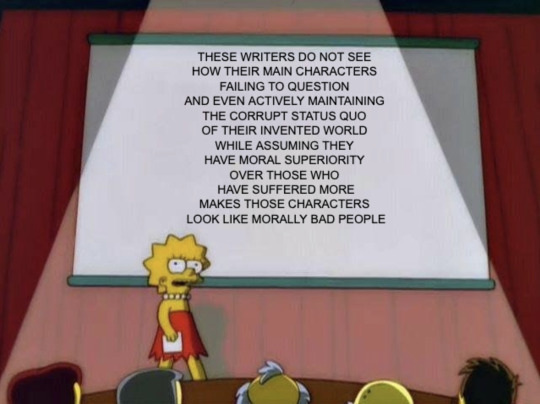
#anon#unofficial adam answers#rwde#yeah even if the thought isn't entirely formed it gets the point across crystal clear#do i think these writers don't know how fucked up the world they wrote is? and that it's odd their mains don't seem to care?#who's to say
44 notes
·
View notes
Text
Animal Model Market Outlook, Demand, Size and Research Report 2023-2028
IMARC Group, a leading market research company, has recently released a report titled “Animal Model Market: Global Industry Trends, Share, Size, Growth, Opportunity and Forecast 2023-2028.” The study provides a detailed analysis of the industry, including the global animal model market size, share, trends, and growth forecasts. The report also includes competitor and regional analysis and…

View On WordPress
#Animal Model Market#Animal Model Market Drivers#Animal Model Market Growth#Animal Model Market Size#Animal Model Market Trends#Global Animal Model Market
0 notes
Text
Breaking Boundaries: How Metaverse Development Companies are Shaping the Future
In today’s fast-paced digital world, the idea of the Metaverse has transformed from a mere fiction into a real and engaging space that is set to revolutionize how we interact with technology. Leading the charge are the metaverse development companies, who are shaping the future. They are pushing limits, questioning norms, and building the groundwork for a future where the lines between the real and virtual worlds fade away.
The metaverse has become a hot topic, grabbing the attention of tech experts, investors, and fans. It’s a virtual reality world where people can interact with 3D environments and each other, opening up endless opportunities and exciting possibilities.
“In January 2023, Google saw about 1.9 million searches worldwide for the word ‘metaverse’.”
With the rising popularity of the metaverse, there’s a growing demand for companies specializing in metaverse development to build and manage these virtual worlds.
Creating immersive and lifelike environments is crucial in metaverse development. This involves a strong grasp of technical and creative elements to create virtual worlds that feel real. A Metaverse development company needs a skilled team capable of everything from 3D modeling and animation to programming and interface design, ensuring captivating user experiences.
In this article, we’ll discuss the importance of metaverse development and the key role played by Metaverse Development Companies in shaping this advanced digital world.
What Is Metaverse?
The Metaverse is a collective virtual shared space, created by the convergence of virtual reality (VR), augmented reality (AR), the internet, and other emerging technologies. It’s essentially a digital universe where users can interact with each other and digital objects in real-time, often through avatars.
The concept originated from science fiction but is now becoming a reality with the advancement of technology. It’s envisioned as a persistent, immersive, and interconnected virtual world with limitless possibilities for socializing, gaming, business, education, and much more.
Important Statistics Showing the Metaverse’s Success:
By 2027, the global metaverse market is projected to expand at a Compound Annual Growth Rate (CAGR) of 47.2%, from $61.8 billion to an impressive $426.9 billion.
In the metaverse, real estate worth over $500 million has already been sold.
Nearly 400 million users actively engage with the metaverse every month.
The metaverse is currently under active development by over 500 companies.
Research predicts that by 2026, at least 25% of people will spend at least one hour daily in the metaverse, whether for work, shopping, education, or entertainment.
Why are new entrepreneurs investing in metaverse development companies?
Let’s explore how metaverse developers can assist businesses in various ways:
Creating a unique virtual world
Metaverse development companies help businesses in creating a unique and captivating virtual environment. They contribute to designing its appearance, integrating interactive features, and programming functionalities to enhance user immersion and enjoyment, ultimately setting them apart from competitors.
Building a social platform
Metaverse development companies can assist entrepreneurs in constructing a social platform within their virtual world. This platform enables users to interact and form communities, fostering a sense of belonging and community spirit. Such initiatives often result in increased user engagement and loyalty.
Generating revenue from the virtual world
Metaverse experts can aid entrepreneurs in monetizing their virtual world using strategies like in-world advertisements, virtual currencies, and other monetization methods. This approach can generate income for the entrepreneur and establish a sustainable business model for their virtual world.
Technical Support
Metaverse experts can assist entrepreneurs with technical support for maintaining, updating, and troubleshooting their virtual world. This support allows entrepreneurs to focus on community building and monetization efforts without worrying about technical issues.
Creating Networking Opportunities
Metaverse developers can facilitate networking for entrepreneurs by connecting them with other professionals in their industry or potential investors. This networking can significantly contribute to the growth of their business.
Fostering Innovation
Metaverse developers aid entrepreneurs in staying at the forefront of technology and innovation. This support enables entrepreneurs to remain competitive and attract new users.
Therefore, a metaverse development company can assist entrepreneurs in establishing and sustaining a thriving virtual world that appeals to users and generates revenue. They offer comprehensive services covering technical and creative aspects, enabling entrepreneurs to concentrate on expanding their businesses and communities.
How Metaverse Development Companies are Shaping the Future?
Metaverse development companies are driving a significant shift across industries, leveraging cutting-edge technology to redefine how we experience and interact with the world. Let’s explore how these companies are shaping tomorrow’s world today.
Real Estate
Virtual property tours have become a game-changer in the real estate industry, with a staggering 49% increase in sales attributed to these immersive experiences. These tours allow potential buyers to explore properties remotely, providing a comprehensive view of the space without the need for physical visits. Enhanced visualization tools further augment this experience, enabling buyers to customize virtual spaces and visualize potential renovations or designs. As a result, decision-making processes are streamlined, leading to quicker transactions and a 30% reduction in time-to-sale.
Healthcare
Metaverse development companies are making significant strides in healthcare by leveraging virtual reality (VR) technology. VR therapy sessions, for instance, have shown remarkable results, with a 65% improvement in patient outcomes compared to traditional therapy methods. Telemedicine platforms powered by the Metaverse enable healthcare providers to conduct virtual consultations, reaching and serving remote patients effectively. Furthermore, training simulations using VR technology are enhancing medical education and skills development among healthcare professionals.
Education
The education sector is witnessing a transformational shift with the integration of Metaverse technology. Immersive learning experiences within virtual environments have led to a remarkable 78% rise in student engagement. Virtual classrooms break down geographical barriers, providing students worldwide with access to quality education and expert instructors. Interactive simulations offer hands-on learning opportunities, facilitating better understanding and retention of complex concepts across various subjects.
Gaming
Metaverse development companies are at the forefront of revolutionizing the gaming industry. Virtual worlds created by these companies offer unparalleled levels of immersion and social interaction for gamers. In-game economies driven by virtual currencies are fostering a new wave of virtual commerce and entrepreneurship. The rise of eSports tournaments within the Metaverse has attracted millions of viewers and lucrative sponsorships, cementing gaming as a major entertainment and economic force in the digital realm.
Fashion
Fashion is embracing the Metaverse with innovative experiences such as virtual try-on sessions. These experiences not only reduce returns but also enhance customer satisfaction by allowing individuals to visualize how clothing and accessories look on them before making a purchase. Digital fashion shows hosted in virtual environments are expanding the reach of designers and brands globally, democratizing access to fashion events. Additionally, the use of non-fungible tokens (NFTs) is revolutionizing ownership and authenticity within the fashion industry, creating new avenues for creators and collectors alike.
Finance
Metaverse development companies are reshaping the financial landscape through virtual banking and investment platforms. These platforms offer personalized experiences tailored to individual financial needs and goals. Blockchain technology, integral to the Metaverse, ensures secure and transparent transactions, enhancing trust and efficiency in financial services. Metaverse assets, including virtual real estate and digital collectibles, are becoming valuable investment opportunities and diversification tools for individuals and institutions alike. Each of these industries showcases how Metaverse development companies are driving innovation, improving experiences, and shaping the future of business and interaction.
Conclusion
As the metaverse evolves and captures the interest of people and businesses, Metaverse Development Companies play a vital role. They act as the creators of the virtual world, blending various technologies to craft immersive, connected, and socially engaging digital experiences. With the rising need for metaverse development, partnering with a trusted Metaverse Development Company is crucial for those aiming to lead in this transformative digital era. Embracing the metaverse now opens doors to endless possibilities in the future.
ibentos is a leading Metaverse Development Company renowned for its innovative approach and expertise in creating dynamic virtual environments. With a focus on cutting-edge technology and user-centric design, Ibentos empowers entrepreneurs to unlock the full potential of the metaverse, from building captivating virtual worlds to implementing revenue-generating strategies. For those ready to embark on their metaverse journey and harness the power of this digital frontier, partnering with Ibentos ensures access to top-notch development solutions and industry-leading expertise. Take the first step towards a vibrant metaverse presence with Ibentos today!
Source: https://ibentos.com/blogs/breaking-boundaries-how-metaverse-development-companies-are-shaping-the-future/
2 notes
·
View notes
Text
Healthcare Market Research: Why Does It Matter?
Healthcare market research (MR) providers interact with several stakeholders to discover and learn about in-demand treatment strategies and patients’ requirements. Their insightful reports empower medical professionals, insurance companies, and pharma businesses to engage with patients in more fulfilling ways. This post will elaborate on the growing importance of healthcare market research.
What is Healthcare Market Research?
Market research describes consumer and competitor behaviors using first-hand or public data collection methods, like surveys and web scraping. In medicine and life sciences, clinicians and accessibility device developers can leverage it to improve patient outcomes. They grow faster by enhancing their approaches as validated MR reports recommend.
Finding key opinion leaders (KOL), predicting demand dynamics, or evaluating brand recognition efforts becomes more manageable thanks to domain-relevant healthcare market research consulting. Although primary MR helps with authority-building, monitoring how others in the target field innovate their business models is also essential. So, global health and life science enterprises value secondary market research as much as primary data-gathering procedures.
The Importance of Modern Healthcare Market Research
1| Learning What Competitors Might Do Next
Businesses must beware of market share fluctuations due to competitors’ expansion strategies. If your clients are more likely to seek help from rival brands, this situation suggests failure to compete.
Companies might provide fitness products, over-the-counter (OTC) medicines, or childcare facilities. However, they will always lose to a competitor who can satisfy the stakeholders’ demands more efficiently. These developments evolve over the years, during which you can study and estimate business rivals’ future vision.
You want to track competing businesses’ press releases, public announcements, new product launches, and marketing efforts. You must also analyze their quarter-on-quarter market performance. If the data processing scope exceeds your tech capabilities, consider using healthcare data management services offering competitive intelligence integrations.
2| Understanding Patients and Their Needs for Unique Treatment
Patients can experience unwanted bodily changes upon consuming a medicine improperly. Otherwise, they might struggle to use your accessibility technology. If healthcare providers implement a user-friendly feedback and complaint collection system, they can reduce delays. As a result, patients will find a cure for their discomfort more efficiently.
However, processing descriptive responses through manual means is no longer necessary. Most market research teams have embraced automated unstructured data processing breakthroughs. They can guess a customer’s emotions and intentions from submitted texts without frequent human intervention. This era of machine learning (ML) offers ample opportunities to train ML systems to sort patients’ responses quickly.
So, life science companies can increase their employees’ productivity if their healthcare market research providers support ML-based feedback sorting and automation strategies.
Besides, hospitals, rehabilitation centers, and animal care facilities can incorporate virtual or physical robots powered by conversational artificial intelligence (AI). Doing so is one of the potential approaches to addressing certain patients’ loneliness problems throughout hospitalization. Utilize MR to ask your stakeholders whether such integrations improve their living standards.
3| Improving Marketing and Sales
Healthcare market research aids pharma and biotechnology corporations to categorize customer preferences according to their impact on sales. It also reveals how brands can appeal to more people when introducing a new product or service. One approach is to shut down or downscale poorly performing ideas.
If a healthcare facility can reduce resources spent on underperforming promotions, it can redirect them to more engaging campaigns. Likewise, MR specialists let patients and doctors directly communicate their misgivings about such a medicine or treatment via online channels. The scale of these surveys can extend to national, continental, or global markets. It is more accessible as cloud platforms flexibly adjust the resources a market research project may need.
With consistent communication involving doctors, patients, equipment vendors, and pharmaceutical brands, the healthcare industry will be more accountable. It will thrive sustainably.
Healthcare Market Research: Is It Ethical?
Market researchers in healthcare and life sciences will rely more on data-led planning as competition increases and customers demand richer experiences like telemedicine. Remember, it is not surprising how awareness regarding healthcare infrastructure has skyrocketed since 2020. At the same time, life science companies must proceed with caution when handling sensitive data in a patient’s clinical history.
On one hand, universities and private research projects need more healthcare data. Meanwhile, threats of clinical record misuse are real, having irreparable financial and psychological damage potential.
Ideally, hospitals, laboratories, and pharmaceutical firms must inform patients about the use of health records for research or treatment intervention. Today, reputed data providers often conduct MR surveys, use focus groups, and scan scholarly research publications. They want to respect patients’ choice in who gets to store, modify, and share the data.
Best Practices for Healthcare Market Research Projects
Legal requirements affecting healthcare data analysis, market research, finance, and ethics vary worldwide. Your data providers must recognize and respect this reality. Otherwise, gathering, storing, analyzing, sharing, or deleting a patient’s clinical records can increase legal risks.
Even if a healthcare business has no malicious intention behind extracting insights, cybercriminals can steal healthcare data. Therefore, invest in robust IT infrastructure, partner with experts, and prioritize data governance.
Like customer-centricity in commercial market research applications, dedicate your design philosophy to patient-centricity.
Incorporating health economics and outcomes research (HEOR) will depend on real-world evidence (RWE). Therefore, protect data integrity and increase quality management standards. If required, find automated data validation assistance and develop or rent big data facilities.
Capture data on present industry trends while maintaining a grasp on long-term objectives. After all, a lot of data is excellent for accuracy, but relevance is the backbone of analytical excellence and business focus.
Conclusion
Given this situation, transparency is the key to protecting stakeholder faith in healthcare data management. As such, MR consultants must act accordingly. Healthcare market research is not unethical. Yet, this statement stays valid only if a standardized framework specifies when patients’ consent trumps medical researchers’ data requirements. Healthcare market research is not unethical. Yet, this statement stays valid only if a standardized framework specifies when patients’ consent trumps medical researchers’ data requirements.
Market research techniques can help fix the long-standing communication and ethics issues in doctor-patient relationships if appropriately configured, highlighting their importance in the healthcare industry’s progress. When patients willingly cooperate with MR specialists, identifying recovery challenges or clinical devices’ ergonomic failures is quick. No wonder that health and life sciences organizations want to optimize their offerings by using market research.
2 notes
·
View notes
Text
Unraveling the Whys Behind Pursuing a B Design Degree
In an era where creativity and innovation are paramount, a Bachelor of Design (B Des) degree stands out as a gateway to a Range of exciting career opportunities.

The design industry, encompassing fields such as fashion, interior, graphic, industrial, and multimedia design, demands professionals who can think creatively and solve complex problems with aesthetic sensibility.
Let’s understand the reasons why pursuing a B Design degree is a worthwhile investment, exploring the course structure, career prospects, and the advantages of studying at leading institutions.
Understanding B Design
A Bachelor of Design (B Des) is an undergraduate degree that equips students with the knowledge and skills necessary to succeed in various design-related fields. The course typically spans four years, covering both theoretical and practical aspects of design. It is structured to foster creativity, technical proficiency, and a deep understanding of design principles.
Key Components of the B Design Course
Foundation Courses: These include basic design principles, color theory, sketching, and model making, which form the bedrock of all design disciplines.
Core Subjects: Depending on the chosen specialization, core subjects may include typography, digital media, textile design, fashion illustration, or product design.
Electives: Students can choose from a range of elective courses to tailor their education to their interests. These might include courses in photography, animation, user experience design, or sustainable design.
Practical Workshops and Labs: Hands-on learning through workshops and labs is integral to a B Design program, allowing students to apply theoretical knowledge to real-world projects.
Internships and Industry Projects: Many programs include internships and industry projects that provide valuable exposure to the professional design world.
Why Pursue a B Design Degree?
Expanding Career Opportunities
The design industry is vast and ever-evolving, offering numerous career opportunities. With a B Design degree, graduates can pursue roles such as fashion designers, graphic designers, interior designers, product designers, UX/UI designers, and multimedia artists. The demand for skilled designers is growing across industries, from fashion houses and design studios to tech companies and advertising agencies.
Creative Fulfillment
A career in design is inherently creative. For those with a passion for art, aesthetics, and innovation, a B Design degree provides a platform to turn their creative vision into reality. Whether designing a new fashion collection, creating a brand's visual identity, or developing user-friendly digital interfaces, the work of a designer is both challenging and fulfilling.
Technical and Soft Skills Development
B Design programs equip students with a blend of technical and soft skills. On the technical side, students learn various design software, prototyping techniques, and production processes. Equally important are soft skills such as problem-solving, critical thinking, communication, and teamwork. These skills are invaluable in any professional setting and enhance employability.
Industry Relevance and Adaptability
The curriculum of B Design programs is often aligned with industry standards and trends. This ensures that graduates are well-prepared to meet the demands of the job market. Additionally, the design field is known for its adaptability, with designers constantly updating their skills and knowledge to keep pace with technological advancements and changing consumer preferences.
Global Opportunities
Design is a global language, and a B Design degree can open doors to international career opportunities. Designers with strong portfolios and the ability to think creatively are in demand worldwide. Studying design also provides opportunities to participate in international exchange programs, design competitions, and global projects, further broadening one’s horizons.
The Scope of B Design in India
Growing Demand for Designers
India's booming economy and expanding middle class have led to increased demand for well-designed products, spaces, and services. This has created a thriving market for designers across various fields. The fashion industry, for example, is witnessing rapid growth with Indian designers gaining international acclaim. Similarly, the rise of e-commerce and digital media has fueled demand for graphic designers and UX/UI experts.
Government Initiatives
Government initiatives like 'Make in India' and 'Startup India' have provided a significant boost to the design sector. These programs encourage innovation and entrepreneurship, creating opportunities for designers to collaborate with startups and established businesses. Additionally, the emphasis on smart cities and sustainable development has increased the need for interior and industrial designers who can create efficient and eco-friendly solutions.
Academic Excellence and Specialized Institutions
India is home to numerous prestigious design colleges offering comprehensive B Design programs. Institutions like the National Institute of Design (NID), National Institute of Fashion Technology (NIFT), and Shoolini University’s School of Design are renowned for their quality education and industry connections. These institutions provide a robust platform for aspiring designers to hone their skills and launch successful careers.
Career Prospects After B Design
Fashion Designer
Fashion designers create clothing, accessories, and footwear. They work with textiles, patterns, and colors to develop new fashion lines and often collaborate with manufacturers and retailers to bring their designs to market.
Graphic Designer
Graphic designers create visual content for print and digital media. They work on branding, advertising, web design, and more, using software like Adobe Photoshop, Illustrator, and InDesign to create visually appealing and effective designs.
Interior Designer
Interior designers plan and design the interiors of homes, offices, retail spaces, and other buildings. They focus on creating functional, aesthetically pleasing environments that meet the needs of their clients.
Product Designer
Product designers develop new products or improve existing ones. They work on everything from consumer electronics to furniture, considering both aesthetics and functionality.
UX/UI Designer
User experience (UX) and user interface (UI) designers focus on creating intuitive and user-friendly digital interfaces. They conduct user research, design wireframes and prototypes, and collaborate with developers to ensure a seamless user experience.
Pursuing a B Design degree is a valuable investment for those passionate about creativity and innovation. The degree offers diverse career opportunities, personal and professional growth, and the chance to be part of a dynamic and evolving industry.
Shoolini University shares the prestigious title of joint No. 1 private university in India according to the QS World University Rankings 2024.
With the growing demand for skilled designers in India and globally, a B Design degree from a reputable institution like Shoolini University’s School of Design can pave the way for a successful and fulfilling career. Whether you aspire to be a fashion designer, graphic designer, interior designer, or any other type of design professional, the knowledge and skills gained from a B Design program will equip you to make a significant impact in the world of design.
2 notes
·
View notes
Text
The “study” part of study abroad
I was flung hard back into student life this past week when classes resumed with my first class being at 6:45am on Monday. I quite literally had to wake up with the roosters (Vietnam definitely has different standards for where animals can be kept. During my travels around I literally saw cows grazing in urban residential areas).
Classes at FTU meet twice a week for periods of two hours and fifteen minutes. So far my classes have usually began late and/or ended early, but they still end up being longer than what I am used to. One nice thing is that all of my classes are conveniently located in one building. The downside to many classes being in one building, however, is that the elevators get very hectic during class change times. There ends up being a mass of students in line to get on them and then the max amount of people possible squeeze into each elevator. I personally opt to take the stairs over dealing with this. My lowest class is on the sixth floor so I should have killer legs by the time the semester finishes.
Class grades are mostly dependent on a group midterm project and a final exam. There’s not really smaller assessments or assignments. I also have not had to purchase any textbooks or access codes, a typical semester expense that I am glad to not have. All of my classes have Facebook groups where lecture notes and important announcements are posted, and every class has a student monitor who keeps attendance and is available for questions. Although all of my classes are in English, sometimes things are in Vietnamese, but fortunately my peers have been helpful in translating and explaining things.
After all this discussion about my classes I realized I neglected to put which courses I am actually taking, so here they are: International Trade Policy, Basic Marketing, Logistics and International Freight Forwarding, and Supply Chain Management. I am aware that none of these are particularly unique, but one interesting thing I have found about them is they cover content in the context of Vietnam. I just had a meeting for a group project that analyzes the supply chain models of global brands and comparable Vietnamese brands. As a supply chain major I look forward to learning about Vietnam in this context and seeing how this project progresses.
Outside of class I had a fairly relaxed week where the focus was just trying to settle into regular life in Hanoi after traveling around. I tried out a recommended laundry shop. I have found that in Vietnamese cities there’s not usually self-service laundromats, you have to use laundry services where they wash and dry everything for you. They generally charge around $1USD/kg and so far all of the services I have used have done a good job, so I can’t complain.
I also tried more food options within walking distance of where I live. The people who run this one restaurant always try to persuade me to come in whenever I walk past so I finally gave them a chance and realized that I have been sleeping on them. They served very delicious bún chả, a Hanoi specialty consisting of pork served with vermicelli noodles and vegetables. It is also custom to eat seafood spring rolls as a side pairing. It makes for a very filling meal on a rainy Hanoi evening. This may sound silly, but I also found that the Circle K is a great spot. There are Circle K’s everywhere and they usually have seating areas. Their banh mi and coffee combo for 21k dong (roughly $0.89) makes a great afternoon pick-me-up between classes. I also like to stop by for late night snacks.
I have also been spending more time with the other exchange students. Sometimes we’ll have meals together and the other night a group of us went to a jazz club just to try something new. I also hope to do more with local students as well, but it has so far been easier to socialize with the exchange students.
I did not think to take many photos this week since I was no longer in tourist mode, but here’s a few, featuring bún chả and jazz as mentioned.


6 notes
·
View notes
Text





Estamos muy contentos por el resultado de nuestro Taller para desarrollar Marcas Personales Sostenible 2WINS que tuvimos el día de hoy.
Fué una gran oportunidad para armar de herramientas fáciles, relevantes y efectivas a nuestros participantes. Los llevamos de la mano por el Efecto Mandela y la prueba del espejo y como nos ayudan a entender mejor el proceso de diseño y creación de tu marca personal sostenible.
Queremos agradecer a nuestro fundador y Head of Branding Engagement Antonio Lovera y a Marcela Quintana responsable del team de Marketing Digital en WholeBranding por su dedicación y compromiso con toda gestión sostenible que sume en este movimiento global.
También queremos agradecer a nuestros aliados de gestión Beaurity®, ECOBRIÓN - Fundación Ecológica de Brión, ResilienciART, Recoinversión Humana, Massphoria, soVIVEart, y Creating Your Next, por todo el apoyo y participación activa. Seguiremos dando mucho de qué hablar, y cumplir con el triple impacto de nuestras gestiones sostenibles.
Hoy muchos lograrón sacar la marca animal que llevaban dentro desde el día que nacieron, y ahora los acompañan en esta nueva aventura.
Te perdiste el taller 2WINS? cero estrés! visita frecuentemente nuestra página web y anótate en el próximo!
4 notes
·
View notes